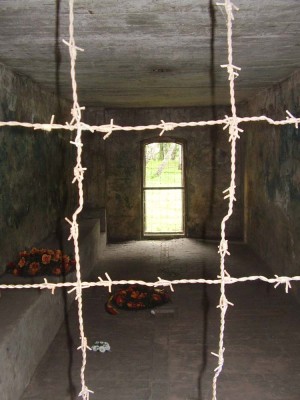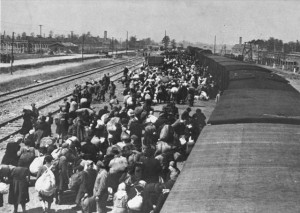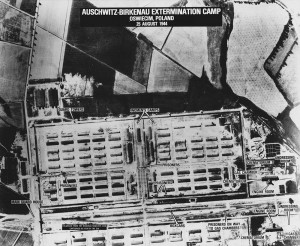 The extermination camps, or death camps as they were also known, were built during World War II by Nazi Germany in countries that they had come to occupy. Between 1939 and 1945 millions of inmates in these camps were systematically killed by gassing or starvation as well as extreme work conditions. The main target of the extermination camps was the Jewish population, although the Jews were not the only targets. The attempted genocide of all Jews by the Nazis was known as the Holocaust.
The extermination camps, or death camps as they were also known, were built during World War II by Nazi Germany in countries that they had come to occupy. Between 1939 and 1945 millions of inmates in these camps were systematically killed by gassing or starvation as well as extreme work conditions. The main target of the extermination camps was the Jewish population, although the Jews were not the only targets. The attempted genocide of all Jews by the Nazis was known as the Holocaust.
Others who became victims to the extermination camp were homosexuals, Slavs, gypsies and mental defectives. The camps’ primary functions were genocide, not punishment for crimes committed with the arrivals at the camps being systematically killed in gas chambers or worked to death.
Location
The most famous concentration camps were built by the Nazis in occupied Poland between 1933 and 1945. At first, those people who were defined as politically or socially undesirable by Nazi society were sent to concentration camps such as Dachau and Belsen. However, after 1942, the Jews were exported from these concentration camps to death camps, where they were killed.
Distinction from Forced Labor Camps
 The extermination camps built by the Nazis during the holocaust were distinguished from forced labor camps. Forced labor camps that were established in countries occupied by Germany were used for slave labor and the death rate in these camps was the result of physical brutality, starvation, disease, exhaustion and execution.
The extermination camps built by the Nazis during the holocaust were distinguished from forced labor camps. Forced labor camps that were established in countries occupied by Germany were used for slave labor and the death rate in these camps was the result of physical brutality, starvation, disease, exhaustion and execution.
The Nazis made the distinction between the camps as early as 1942. Whereas Auschwitz and Majdanek were used for the mass extermination of inmates through gassing, other camps such as Dachua and Buchenwald were known as concentration camps. This distinction was made clear during the Nuremberg trials where a deputy of Adolf Hitler identified the two clearly different forms of camp.
Famous Concentration Camps
The largest and most well known concentration camp was Auschwitz. However, there were many other camps in German occupied Poland including Belzec, Majdanek, Sobibor, Treblinka, and Chelmno. At Auschwitz, 100,000 people could be housed at any one time, and the gas chambers could accommodate a frightening 2,000 people.
At the peak, up to 12,000 people were gassed and incinerated each day at Auschwitz. The able bodied who arrived at the camp were initially used for forced labor until they finally met their deaths. They may have died due to the conditions, from starvation, or in the worst of circumstances, they were worked to the brink of death and then exterminated.
Nazi Policy
 The creation of the extermination camp represented a shift in the policy of the Nazis. Starting in June of 1941 when Germany invaded the Soviet Union, Jews were rounded up and taken to execution sites. One such site was BabyYar in the Ukraine. This kind of killing unit was actually mobile and it was difficult to sustain as it attracted attention from local populations.
The creation of the extermination camp represented a shift in the policy of the Nazis. Starting in June of 1941 when Germany invaded the Soviet Union, Jews were rounded up and taken to execution sites. One such site was BabyYar in the Ukraine. This kind of killing unit was actually mobile and it was difficult to sustain as it attracted attention from local populations.
For these reasons, concentration camps were decided on by the Nazis, making the camps a stable killing center and transporting the people to them. A stationary camp could be accessed by rail and would provide a killing center where large numbers of exterminations could be carried out on a daily basis. The stationary camps would also be easier to control and would need less staff to carry out the executions. There were 104 members of staff at Belzec and just 120 at Treblinka of which only around 20 to 30 were from the SS.
Extermination by Gas
The extermination process at the camps was usually administered by means of poison gas. The first camp to use gassing was Chelmo, with the first extermination taking place on December 8, 1941. The extermination worked by asphyxiating the passengers of gas vans with carbon monoxide fumes. At Auschwitz, the largest and most famous of the killing camps, Zyklon-B was used to kill the inmates in massive gas chambers.
Slave Labor
While Belzec, Sobibor, and Treblinka were used for the sole purpose of extermination, Auschwitz and Majdanek were also used for slave labor. The inmates of these camps were put to work in conditions that were inhumane, giving them a glimmer of hope that they might survive. The majority died in the bad conditions, by means of starvation, exhaustion, or later in the gas chambers.
The camps at Treblinka, Sobibor and Belzec closed in 1943, their task being complete with the successful extermination of all the Polish Jews from their former ghettos. Auschwitz on the other hand was still receiving victims to be executed as late as 1945 with the arrival of troops from the Soviet Union.
Camp Statistics
Auschwitz was the largest and most famous of all the extermination camps. It is estimated that 1.1 to 1.5 million Jews were killed there. Between just March of 1942 and early 1943 around 600,000 Jews lost their lives at Belzec. Chelmo, a town around 50 miles from Lodz in Poland was the setting for the first mass killing of Jews by gas poisoning. At Majdanek, killing began in April of 1942 and ended in July of 1944. Slave labor was also in place at this camp, providing workers for the weapons factory Steyr-Daimler-Puch. At this camp the death toll included Poles, Jews, and Soviet POWs and was estimated at around 360,000. Sobibor was home to around 250,000 executions, the vast majority of these being Jews.
The killing at Treblinka started on July 23, 1942 when some 245,000 Jews from a Warsaw ghetto were exterminated. Another 112,000 Jews from other areas within the Warsaw district were murdered there on September 21st. Added to this figure were 35,000 from Lublin and 107,000 from Bialystok. Many thousands of Jews from outside Poland were transported to Treblinka where they met their deaths. These include 7,000 from Slovakia, 4,000 from Greece, and 7,000 from Macedonia. The mass killing at Treblinka included many more Jews from surrounding countries as well as gypsies and other socially inadequate people from around the eastern provinces.